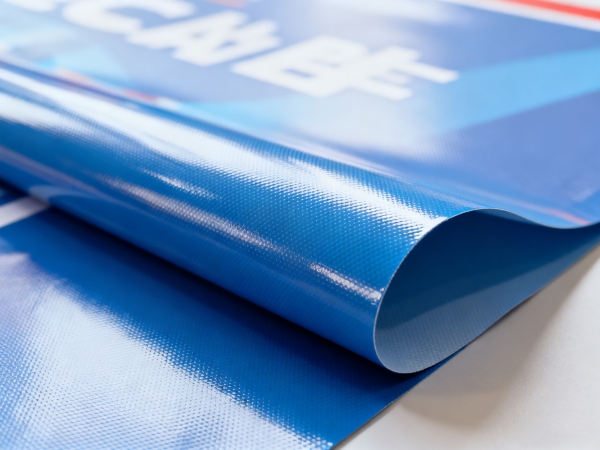What is PVC Fabric?
PVC fabric, or polyvinyl chloride-coated textile, is a composite material made by applying a layer of PVC resin onto a polyester base fabric. This combination results in a highly durable, flexible, and weather-resistant surface ideal for printing and display. The coating not only gives the fabric waterproof and flame-retardant properties but also creates a smooth texture that enhances color vibrancy during printing.
Depending on its thickness and coating process, PVC fabric can be classified into frontlit, backlit, mesh, blockout, and tarpaulin types — each serving specific advertising purposes. For instance, frontlit PVC fabric is designed for single-sided printing, while blockout fabric prevents light penetration for double-sided prints.
Why PVC Fabric is Popular in Advertising

The advertising industry values materials that are durable, printable, and visually impactful. PVC fabric fulfills all these criteria, making it a leading material for both short-term campaigns and long-term installations.
- Excellent Print Reproduction: Its smooth surface allows for high-resolution digital, solvent, or UV printing, ensuring sharp graphics and vivid color reproduction.
- Weather Durability: PVC’s waterproof and UV-resistant nature ensures that outdoor advertisements remain vibrant even under harsh sunlight or heavy rain.
- Versatility: The fabric can be cut, welded, and shaped easily, making it adaptable for a variety of creative advertising structures.
- Cost Efficiency: Compared with textile fabrics or rigid materials like acrylic boards, PVC fabric provides excellent performance at a lower overall cost.
These advantages explain why PVC is used by global advertising firms for outdoor banners, vehicle wraps, and even stadium billboards.
Common Advertising Applications of PVC Fabric
PVC fabric’s adaptability allows it to be used across different advertising platforms:
(1) Outdoor Billboards and Building Wraps
Large-format PVC sheets are used for billboards, ensuring brand visibility from long distances. In cities, PVC mesh fabric is often chosen for building wraps because it allows wind to pass through while maintaining print clarity.
(2) Event Banners and Trade Show Displays
Temporary banners and exhibition stands often rely on PVC frontlit fabric, which offers smooth surfaces for crisp graphics and easy installation with eyelets or frames.
(3) Vehicle and Bus Advertising
PVC self-adhesive films or tarpaulin wraps transform transportation vehicles into mobile advertisements. These wraps must endure wind, dust, and frequent washing — areas where PVC excels thanks to its tensile strength and protective coating.
(4) Inflatable Advertising Structures
PVC tarpaulin is widely used in inflatable arches, mascots, and product replicas, as it maintains air pressure and form even under prolonged outdoor use. Its tear resistance ensures the inflatable remains intact through repeated inflation cycles.
(5) Lightbox and Backlit Displays
For night-time advertising, PVC backlit fabric evenly diffuses light from behind, creating bright, eye-catching displays that enhance brand visibility in dark environments.
Benefits of Using PVC Fabric for Outdoor and Indoor Ads
(1) Superior Weather Resistance
PVC fabric remains stable under heat, cold, and humidity. Its UV coating prevents fading, while waterproofing keeps prints intact through rainy seasons.
(2) High Print Compatibility
It supports solvent, eco-solvent, UV, and latex printing technologies, offering printers flexibility in production methods and color management.
(3) Easy Maintenance and Long Lifespan
Unlike paper or fabric banners that quickly degrade, PVC ads can last for years. Stains or dust can be cleaned with mild detergent without damaging the print.
(4) Flame Retardancy and Safety
High-quality PVC fabrics meet B1 or M2 flame retardant standards, making them safe for indoor use in malls, airports, and trade exhibitions.
(5) Sustainability Options
Eco-conscious manufacturers are now offering phthalate-free and recyclable PVC fabrics, aligning advertising materials with modern environmental goals.
Tips for Choosing the Right PVC Fabric for Advertising
Selecting the right PVC fabric ensures both durability and visual impact. Consider these practical aspects:
Application Environment:
- Use UV-resistant and waterproof fabrics for outdoor billboards.
- Opt for flame-retardant types in indoor exhibitions or enclosed spaces.
Fabric Type and Thickness:
- Frontlit (440–510gsm) for general banners.
- Backlit (510–610gsm) for illuminated displays.
- Blockout (650–850gsm) for double-sided prints.
- Mesh (280–380gsm) for windy or semi-transparent installations.
Surface Finish:
- Glossy finishes make colors more vibrant for eye-catching effects.
- Matte finishes reduce glare under strong lighting or camera flashes.
Finishing Options:
Reinforced edges, welded seams, or eyelets improve lifespan and ease of installation.
Printing Compatibility:
Confirm the fabric suits your printing ink (solvent, UV, or latex) to prevent smudging or color fading.
Finally,
PVC fabric remains a cornerstone material in the advertising world because of its durability, print quality, and design flexibility. From massive outdoor billboards to intricate indoor displays, it offers the strength and vibrancy that brands rely on to capture attention. As sustainable formulations become more available, PVC advertising materials are evolving toward greener, longer-lasting solutions — ensuring that creativity and responsibility can go hand in hand.






























